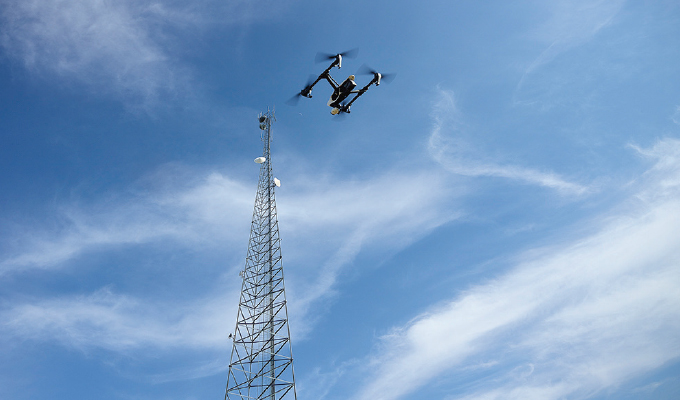Elevating UAS to new heights
By Todd Schlekeway and Jim Goldwater
The National Association of Tower Erectors (NATE) has played a leading role in the wireless and broadcast industries to facilitate the safe and proper integration of unmanned aerial systems into communications tower work. The principal reason, of course, is safety—we estimate that the use of UAS technology can reduce the number of climbs for inspections by one-third.
THE ISSUE
The breadth of this benefit can be illustrated with a simple statistic. There are hundreds of thousands of communication and broadcast towers—some approaching 2,000 feet in height—throughout the United States that will have to be inspected, serviced, and maintained for the rest of their service life. Reducing climbs required for tower inspections is a no-brainer, and doing so through the use of UAS will not result in any loss of jobs; rather, it will actually promote tower work.
Over the last several years, NATE, a non-profit trade organization consisting of more than 900 member companies that construct, service, and maintain communications infrastructure throughout the United States, has had meaningful discussions regarding the commercial use of drones on Capitol Hill, as well as with Federal Aviation Administration officials, the White House Office of Information and Regulatory Affairs, the White House Office of Science and Technology Policy, the National Telecommunications and Information Administration, and key industry and interest groups.
NATE has also met with the Occupational Safety and Health Administration and the Federal Communications Commission; believing that OSHA would be interested because of the reduced risk to workers, and the FCC would be interested because tower work would be facilitated and expedited. As it turned out, they were both interested and intrigued.
While NATE has acknowledged that the act of climbing up or down a tower—oftentimes while the climber is wearing more than 50 pounds of equipment—is inherently risky, NATE has also advised that minimizing the risk caused by climber fatigue, weather, or obstructions is imperative. Couple that risk with significantly greater need for new or modified towers resulting from surging demands for 5G deployment, rural broadband, enhanced public safety requirements stemming from the establishment of the First Responder Network Authority (FirstNet), and the broadcast “repack” that is currently necessitating significant structural work on tall communications towers, and it is easy to understand the substantial additional challenges that tower technicians are confronting, as well as the critical importance of deploying available life-saving techniques.
INITIATIVES TAKEN
To help guide its members through the maze of regulatory and legal requirements, and to further their awareness of the enormous amount of information available, NATE has undertaken a range of initiatives in the UAS arena. The Association has established a UAS Committee, which is composed of tower contractors, licensed pilots, UAS service provider companies, wireless carriers, tower owner/vertical realtor firms, and trainers. NATE unveiled the second edition of the UAS Operations Around Vertical Communication Infrastructure resource document, which is the result of collaboration between the UAS Committee and other prominent representatives from the commercial UAS industry. NATE also produced a UAS Operations Safety Video, accessible on the Association’s YouTube channel, as part of the Association’s popular Climber Connection campaign.
NATE also organized a UAS Operations Field Day Showcase at a tower site in Gainesville, Virginia. At the event, attendees representing government agencies and the industry experienced the unique opportunity to witness live flight demonstrations conducted by prominent drone service provider companies operating in the industry. The many applications and use cases for drones in the wireless industry were showcased in real-time directly from the tower site.
NATE also continues to participate in a variety of UAS-related undertakings. For example, the Association is an active member of the Commercial Drone Alliance and works with the Association for Unmanned Vehicle Systems International. Additionally, Association representatives serve on several Unmanned Safety Teams (UAST) working groups under the leadership of the FAA, addressing such topics as injury reduction and improving safety.
INTEGRATION OF TECH
Sticking with the FAA: NATE strongly supports the range of UAS-related initiatives advanced by the FAA to enhance air safety, particularly the registration requirements. Additionally, the Association applauds the agency for its efforts to work with parties interested in utilizing UAS for commercial purposes through Part 107. The provisions outlined in Part 107 provide an excellent framework that will help with the safe integration of UAS technology into the communications tower industry.
Of course, there remain a number of issues that must be addressed by regulatory and/or legislative entities. For example, additional antennas are being placed on existing towers, utility structures, light poles, and rooftops, which means that it is essential that the FAA and the Office of Management and Budget provide sufficient flexibility in the rules to permit work to be done in a safe and reasonable fashion over people.
CLOSING THOUGHT
The bottom line for NATE is that the proper use of unmanned aerial systems can help save lives while promoting productivity in the communications tower industry. NATE heartily endorses the safe deployment of this technology. It is unquestionably in the public good.
About the author:
Todd Schlekeway is the executive director of NATE. Todd can be contacted via email at todd@natehome.com. Jim Goldwater is the director of legislative & regulatory affairs at NATE. Jim can be contacted via email at jimauh2o@aol.com.
Modern Contractor Solutions, January 2020
Did you enjoy this article?
Subscribe to the FREE Digital Edition of Modern Contractor Solutions magazine.



